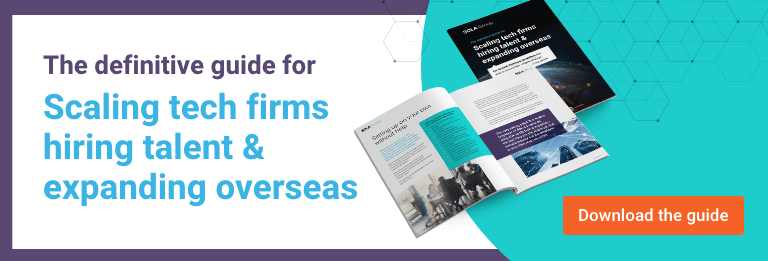Take-off happens at a time of critical stress for pilot and aircraft alike. It is a pivotal moment that must be completed without fault to ensure success—or there will be hazardous consequences. A pilot needs to be in total control of the plane and have complete information from air traffic control to minimise risk. Flying and corporate global expansion share many similarities, and to ensure success in both, they should be approached with a similar level of care, talent, and expertise.
The traditional route to global expansion: EoR and PEO solutions
Collectively, EoRs (Employers of Record) and PEOs (Professional Employment Organisations) are thought to be the best global expansion solutions. The terms are often used interchangeably, although there are several key distinctions between the two services.
What is an EoR?
An EoR is a third-party service that enables businesses to expand overseas employees without having to open an overseas entity themselves. The EoR assumes the role of the local, legal employer in the foreign jurisdiction.
It can then undertake several functions, including onboarding and paying international employees as well as adhering to local laws. EoRs also take care of a few of the average HR and administrative duties.
If an EoR has no direct operation in the target jurisdiction(s), they often hire third-party subcontractors to employ workers. Those subcontractors have no legal relationship with the EoR’s client and are not controlled by the EoR.
What is a PEO
Like the EoR, the PEO employs workers locally using one of its own companies or a subcontractor. However, in the PEO model, both the client and the PEO employ the workers together—known as co-employment.
When hiring an employee using the co-employment model, the PEO and its client share rights, responsibilities, and legal obligations. Also, PEOs provide some basic HR and administrative support to clients in foreign jurisdictions—much the same as EoRs.
Are there benefits of EoRs and PEOs?
Of course there are. Unlike trying to establish a foreign subsidiary by yourself, akin to flying without talking to air traffic control, EoR and PEOs offer a basic level of structure and guidance that can help companies looking to expand in four key areas.
- Reduced time to market
- Increased time to focus on global expansion
- Some basic assured HR functions
- Some basic assistance with local compliance
So, what are the pitfalls of these traditional global expansion solutions?
EoRs and PEOs are well-known solutions that have been around in some form since the 1960s. They were designed to help businesses expand and relieve them from the ever-increasing human resources, regulatory, compliance, and legal pressures relating to constantly changing employment laws. However, they are not without risk.
At first, they may appear to be a quick and easy fix for companies looking to expand globally, but they are legally ambiguous solutions that create significant legal and financial risk for the client seeking global expansion.
Each global expansion solution has the same three principal shortcomings (although they differ slightly for each one):
- They expose the client to lawsuits from foreign countries either from the employee themselves or from others suing over what they did or did not do.
- They put the client’s existing Intellectual Property at risk; plus, they often fail to have the new locally generated IP transferred to them.
- They do not offer employees continuation of employment. This means when it’s time to transfer your loyal, local workers into your new subsidiary—they lose all of their valuable, accrued local employment law rights.
The big problem with EoRs is being the employer but not the employer
The very selling point that makes Employer of Record services attractive to US tech companies—the fact they are the employer; but simultaneously not the employer—is also their main downfall.
Why?
Because they’re not really the sole employer—you are too.
(1) No protection from legal proceedings
EoRs claim to act as a legal barrier between the employee and the US tech company; however, in reality, they do not provide anything like as much protection as promised.
Although the EoR is supposed to be the legal employer of the employee, they are not legally able to direct or control the employee as they have no managerial rights. This means the US customer tech firm is (legally) the employer in the eyes of the local employment law, destroying the legal barrier the EoR seeks to erect between its customer and the employee it employs for them.
(2) No Intellectual Property (IP) access is granted to employees
In a traditional employment relationship, an employer can give a task to an employee, which automatically allows them to work on the company’s IP (e.g., report updates, sales presentations, code development, etc.). And when new IP is produced, it automatically becomes owned by the employer.
But when the EoR is the ‘on paper’ employer, it does not have the automatic legal authority to grant access to its client’s IP. There is no legal mechanism through which an EoR-hired employee can work on that IP; thus, technically, no work can be carried out. Additionally, any new IP created by the employee is legally the property of the EoR because the written contract of employment is between them.
(3) No continuation of employment
Most companies plan to use an EoR solution until the overseas effort has bedded in and become successful, at which point they set up their own legal entity. When they do this, the employees that had been working for them through the EoR need to be transferred to their entity.
Most local laws have regulations that control what happens when one company transfers employees to another company—known as TUPE in the UK, for example. These local laws are highly valued by local employees; they are often time-related, and the longer the employee is employed, the greater their local Employment Law rights.
However, the problem arises when the US company uses an EoR as a long-term temporary employer of its employees—which is the entire purpose of the relationship. Because the EoR is an ‘on paper’ employer rather than the exclusive employer, it cannot transfer employees compliantly when it opens its own overseas entity, which means there cannot be continuity of employment.
This can negatively affect the chances of recruiting and retaining top talent. If employees are not compliantly transferred, they will lose valued worker employment rights when transferred to the company’s own overseas entity—which many companies promise to do.
The big issue with PEOs: the co-employment contract
Organisations offering PEO services have to sign co-employment contracts with their overseas partners. However, while PEOs may be adept at understanding some employment law and undertaking some rudimentary local law obligations, the co-employment model creates three severe problems for PEO clients.
(1) No protection from legal proceedings
The co-employment model means that the US-based PEO client continues to have full legal obligations as they are still an employer. One of the most serious issues is their continuous legal liability under foreign law in foreign legal jurisdictions and subject to foreign courts of law.
For example, a US company could retain a PEO in the UK to hire and provide HR services for ten employees in the UK and five in France. The PEO would use a local entity in France (possibly a subcontractor) as its PEO partner to hire the five employees and provide HR services. Because of co-employment, the US company would be:
- Liable in UK courts for their UK employees under UK Law
- Liable in UK courts for their French Employees under French Law
And if an employee in France had a grievance, the employee would be able to sue the US company in French courts under French Law using French Legal Procedure. The fact that the PEO provider is the local co-employer offers zero protection against legal proceedings.
Even if the PEO was only contracted to hire employees in the UK, the US company would still be liable in that jurisdiction. US companies that use PEOs are generally unaware of the very significant pitfalls of signing co-employment contracts. They believe, understandably, that they are legally covered under the model—which is not the case.
If an unfortunate situation does happen, a US-based company could find itself being sued in a foreign court; its lawyers do not speak the language and have no experience with the foreign legal system.
This presents great risks, and the likelihood of success is as low as the costs will be colossal.
(2) Loss of Intellectual Property (IP)
The co-employment contract signed by both the US-based company and the PEO produces a complex legal situation that is wholly disadvantageous for the US company. The IP created by the employee will belong to both co-employers, and it will not be subject to US Law or created under US Law. It will be foreign law IP jointly owned with the PEO—a worrying situation that significantly reduces its value.
For example, a computer programmer working in the UK may create mini-programs, scripts, patches, or localisations for their PEO’s client in California. As the US company signed a co-employment contract with a UK-based PEO, the software created by the programmer will legally belong to both the PEO and the US company. In certain situations, the employee may even own the IP. The same is true for local CRMs and customer data.
This situation is a great risk for the US-based company. The co-employment contract they sign means they may never be the complete owner of their own IP—instead, it will be fragmented across foreign legal jurisdictions and entangled with the joint ownership of the PEO and their subcontractors. A danger for the US IP owner, and a hazard for their stakeholders and investors.
The PEO is always a high-risk “solution”.
(3) No continuation of employment
Companies employing employees through a PEO generally only intend to use the third party until their operation is large enough to open an entity in a foreign jurisdiction. This may take around three years. When the company does open its own entity and hire its own employees directly, it will want to transfer all of the PEO employees that currently work for the company.
However, PEO transfers do not allow the continuation of employment from co-employment to sole employment. Co-employment arrangements mean employees lose out on the existing terms and conditions of their employment and their continuity of service, which do not legally transfer with them.
They will lose some of their most important legal rights to sick pay, and accrued entitlements such as bonuses and holidays, as well as specific protections around dismissal and redundancy.
There are clear, stark consequences of not offering a continuation of employment.
Conclusion
Much trust is at stake when companies expand globally. Just like when you are flying, you want to make sure that whoever is taking you on the journey has planned for everything. Turbulence can happen at any time, but when it does, you want to be covered.



